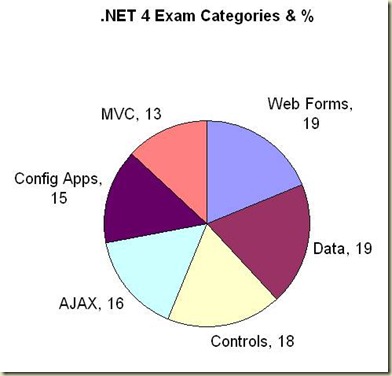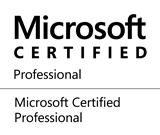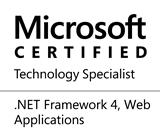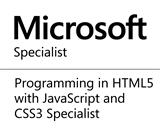How to Pass MCTS 070515 Certification Exam
Being certified is good, it a marker that indicates that you have a mastery of
a technology, but it can never be substituted for on field experience.
As a certified professional, coupled with your on field experience, you have an edge and advantage over others when it comes to looking for job.
The acceptability of Microsoft based technology certifications is growing, as an MCTS you have access to numerous resources and materials that can make you self-sufficient and empowered to upgrade on your own.
To prepare for Microsoft Certified Technology Specialist(MCTS) in Web Applications development with Microsoft .Net Framework 4 exam is not too hard, as somebody who is already familiar with developing web application using ASP.net 4.0, but for someone who is just starting web development with Asp.net, it might not be easy.
You must start preparing at least two months before the day you intend to sit for the exam, the book by Tony NorThrup and Mike Snell MCTS Self-Paced Training Kit (Exam 70-515) is good and it will put you through what it takes to pass the exam.
I will recommend that you read MSDN documentations on the topics below, I will also suggest that you visit this page as well
This is the exam objective and the percentage obtainable
1 Developing Web Forms Pages (19%)
• 1.1 Configure Web Forms pages.
• 1.2 Implement master pages & themes.
• 1.3 Implement globalization.
• 1.4 Handle page life cycle events.
• 1.5 Implement caching.
• 1.6 Manage state.
2 Developing and Using Web Forms Controls (18%)
• 2.1 Validate user input.
• 2.2 Create page layout.
• 2.3 Implement user controls.
• 2.4 Implement server controls.
• 2.5 Manipulate user interface controls from code-behind.
3 Implementing Client-Side Scripting and AJAX (16%)
• 3.1 Add dynamic features to a page by using JavaScript.
• 3.2 Alter a page dynamically by manipulating the DOM.
• 3.3 Handle JavaScript events.
• 3.4 Implement ASP.NET AJAX.
• 3.5 Implement AJAX by using jQuery.
4 Configuring and Extending a Web Application (15%)
• 4.1 Configure authentication & authorization.
• 4.2 Configure providers.
• 4.3 Create and configure HttpHandlers and HttpModules.
• 4.4 Configure initialization and error handling.
• 4.5 Reference and configure ASMX and WCF services.
• 4.6 Configure projects and solutions, and reference assemblies.
• 4.7 Debug a Web application.
• 4.8 Deploy a Web application.
5 Displaying and Manipulating Data (19%)
• 5.1 Implement data-bound controls.
• 5.2 Implement DataSource controls.
• 5.3 Query and manipulate data by using LINQ.
• 5.4 Create and consume a data service.
• 5.5 Create and configure a Dynamic Data project.
6 Developing a Web Application by Using ASP.NET MVC 2 (13%)
• 6.1 Create custom routes.
• 6.2 Create controllers & actions.
• 6.3 Structure an ASP.NET MVC application.
• 6.4 Create and customize views.

Wish you best of luck in the exam!
As a certified professional, coupled with your on field experience, you have an edge and advantage over others when it comes to looking for job.
The acceptability of Microsoft based technology certifications is growing, as an MCTS you have access to numerous resources and materials that can make you self-sufficient and empowered to upgrade on your own.
To prepare for Microsoft Certified Technology Specialist(MCTS) in Web Applications development with Microsoft .Net Framework 4 exam is not too hard, as somebody who is already familiar with developing web application using ASP.net 4.0, but for someone who is just starting web development with Asp.net, it might not be easy.
You must start preparing at least two months before the day you intend to sit for the exam, the book by Tony NorThrup and Mike Snell MCTS Self-Paced Training Kit (Exam 70-515) is good and it will put you through what it takes to pass the exam.
I will recommend that you read MSDN documentations on the topics below, I will also suggest that you visit this page as well
This is the exam objective and the percentage obtainable
1 Developing Web Forms Pages (19%)
• 1.1 Configure Web Forms pages.
• 1.2 Implement master pages & themes.
• 1.3 Implement globalization.
• 1.4 Handle page life cycle events.
• 1.5 Implement caching.
• 1.6 Manage state.
2 Developing and Using Web Forms Controls (18%)
• 2.1 Validate user input.
• 2.2 Create page layout.
• 2.3 Implement user controls.
• 2.4 Implement server controls.
• 2.5 Manipulate user interface controls from code-behind.
3 Implementing Client-Side Scripting and AJAX (16%)
• 3.1 Add dynamic features to a page by using JavaScript.
• 3.2 Alter a page dynamically by manipulating the DOM.
• 3.3 Handle JavaScript events.
• 3.4 Implement ASP.NET AJAX.
• 3.5 Implement AJAX by using jQuery.
4 Configuring and Extending a Web Application (15%)
• 4.1 Configure authentication & authorization.
• 4.2 Configure providers.
• 4.3 Create and configure HttpHandlers and HttpModules.
• 4.4 Configure initialization and error handling.
• 4.5 Reference and configure ASMX and WCF services.
• 4.6 Configure projects and solutions, and reference assemblies.
• 4.7 Debug a Web application.
• 4.8 Deploy a Web application.
5 Displaying and Manipulating Data (19%)
• 5.1 Implement data-bound controls.
• 5.2 Implement DataSource controls.
• 5.3 Query and manipulate data by using LINQ.
• 5.4 Create and consume a data service.
• 5.5 Create and configure a Dynamic Data project.
6 Developing a Web Application by Using ASP.NET MVC 2 (13%)
• 6.1 Create custom routes.
• 6.2 Create controllers & actions.
• 6.3 Structure an ASP.NET MVC application.
• 6.4 Create and customize views.

Wish you best of luck in the exam!
Share this page on
2
People Like(s) This Page
 Permalink
Permalink
comments powered by Disqus






